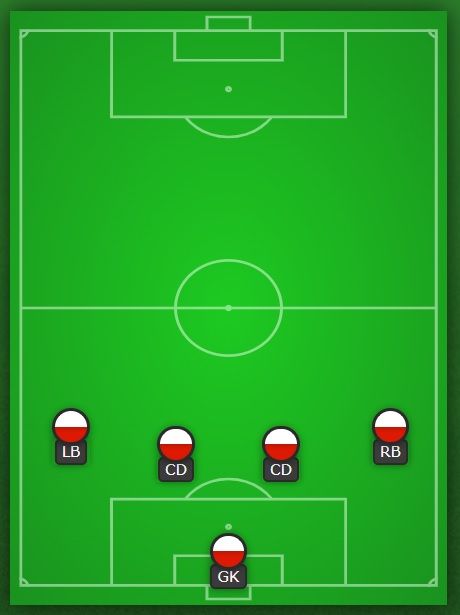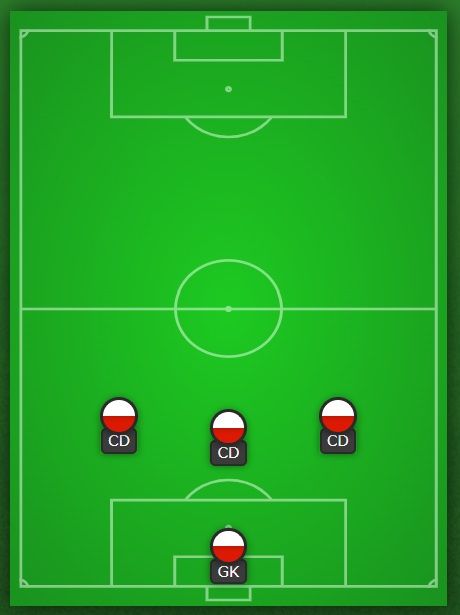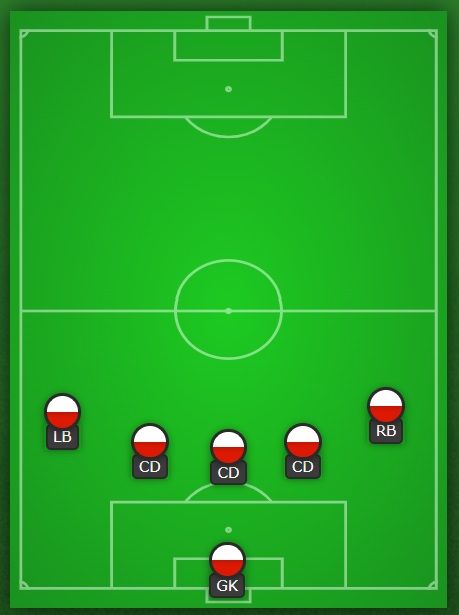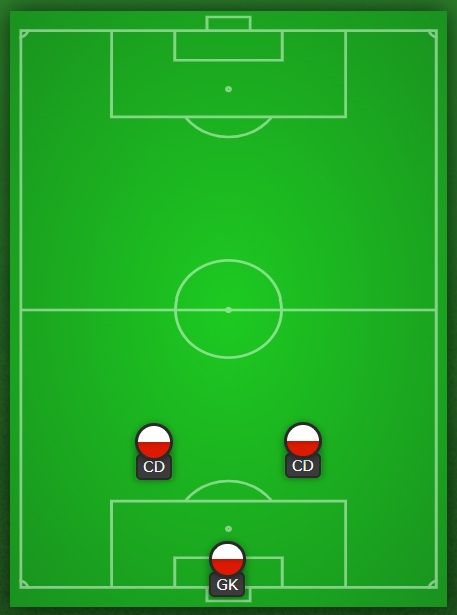Copyright © 2018-2024 nothrow.com. All Rights Reserved. You may not copy and distribute the content from the Site.
A team formation in football (often simply referred to as “formation”) describes how players are positioned on the field.
It is a tactical blueprint that determines player positions, roles, and responsibilities during a match.
Formations are typically described using numbers, which represent the number of players in each line of the field, starting from the defense and moving forward to the attack.
The choice of formation can influence a team’s style of play, and it can vary based on the opponent, the tactics the coach wants to employ, or the players available for a particular match.
Formations can be adjusted during a game depending on the situation (e.g., if a team is trailing and needs to score, they might adopt a more attacking formation).
Some Key Facts:
- ✅ A team formation in football dictates player positions and their roles during a match.
- ✅ The Spanish LaLiga saw a shift from the 4231 formation to the 442 formation between the 2012/13 and 2020/2021 seasons.
- ✅ Top-tier teams in the league, especially Champions League qualifiers, favored the 433 formation.
- ✅ Lower-ranking teams, particularly those near relegation, opted for more defensive formations with five defenders.
What Are the Most Used Formations?
Based on the research, the most used formations in the Spanish LaLiga over the studied seasons were (1):
- 4231 Formation: This was the most common tactical structure from the 2012/13 season to the 2015/17 season.
- 442 Formation: This formation became the most frequent from the 2017/18 season to the 2020/2021 season.
- 433 Formation: This formation was notably prevalent among top-tier teams, especially those that won the league or qualified for the UEFA Champions League.
The Most Comprehensive List of 60 Football Formations
Four at Back (In Defensive Line) Formations

4-4-2 (Classic)
Description: A balanced formation with two banks of four and two strikers.
Key Facts:
- Two central midfielders.
- Two wingers.
- Two strikers up front.
Pros:
- Balanced in both attack and defense.
- Provides width with wingers.
- Two strikers can combine effectively.
Cons:
- Can be outnumbered in midfield against three-man midfields.
- Requires wingers to track back and defend.
4-4-2 (Diamond)
Description: A variation of 4-4-2 with a narrow midfield diamond.
Key Facts:
- No traditional wingers.
- One defensive midfielder, two central midfielders, and one attacking midfielder.
Pros:
- Strong central presence.
- Good for ball retention and short passing play.
Cons:
- Lacks width; can be vulnerable to teams with strong wingers.
- Full-backs need to provide width, leaving potential defensive gaps.
4-4-2 (Box)
Description: A compact 4-4-2 with two defensive and two attacking midfielders.
Key Facts:
- Two defensive midfielders.
- Two attacking midfielders behind the strikers.
Pros:
- Solid defensively with two holding midfielders.
- Attacking midfielders can link up with strikers.
Cons:
- Lacks natural width.
- Can be predictable in attack.
4-3-3 (Flat)
Description: Three midfielders in a line with three forwards ahead.
Key Facts:
- Three central midfielders.
- Two wingers and a central striker.
Pros:
- Versatile in attack with width and central options.
- Midfield trio can dominate possession.
Cons:
- Requires midfielders to be disciplined.
- Striker can be isolated if wingers don’t support.
4-3-3 (Holding)
Description: Features a defensive midfielder with two central midfielders ahead.
Key Facts:
- One defensive midfielder.
- Two central/attacking midfielders.
Pros:
- Solid defensively with a holding midfielder.
- Good balance in midfield.
Cons:
- Requires wingers to track back.
- Can be outnumbered in attack if midfielders don’t push forward.
4-3-3 (Attacking)
Description: Emphasizes on attack with an advanced midfield trio.
Key Facts:
- One holding midfielder.
- Two attacking midfielders.
Pros:
- Strong attacking presence.
- Can break down defensive teams.
Cons:
- Vulnerable to counter-attacks.
- Requires full-backs to provide width.
4-3-3 (False Nine)
Description: A formation with four defenders, three midfielders, and three forwards, where the central striker drops deep, acting more as a playmaker.
Key Facts:
- Four defenders.
- Three midfielders.
- Two wingers.
- One central forward (False Nine).
Pros:
- Fluid attacking movement.
- Central striker can create overloads in midfield.
- Difficult for opponents to mark.
Cons:
- Requires a highly skilled False Nine.
- Can lack a focal point in attack.
- Vulnerable to teams with strong defensive midfielders.
4-2-4
Description: An attacking formation with four forwards and a double pivot in midfield.
Key Facts:
- Two central midfielders.
- Four forwards: two wingers and two strikers.
Pros:
- Strong attacking presence.
- Can overwhelm defenses with sheer numbers.
Cons:
- Can leave the midfield exposed.
- Requires a lot of stamina from players.
4-2-4 (Wide)
Description: Four defenders, two central midfielders, and a four-man forward line with wide wingers.
Key Facts:
- Four defenders.
- Two central midfielders.
- Four forwards with wide wingers.
Pros:
- Strong attacking presence on the flanks.
- Multiple attacking options.
Cons:
- Vulnerable to counter-attacks.
- Requires dynamic full-backs.
4-5-1 (Flat)
Description: A balanced formation with a flat five-man midfield.
Key Facts:
- Five midfielders in a line.
- Single striker up front.
Pros:
- Solid midfield presence.
- Can control possession effectively.
Cons:
- Striker can be isolated.
- Requires midfielders to support the attack.
4-5-1 (Holding)
Description: A defensive variation of 4-5-1 with a holding midfielder.
Key Facts:
- One defensive midfielder.
- Four other midfielders ahead.
Pros:
- Strong defensive solidity.
- Good for counter-attacking play.
Cons:
- Can be less creative in attack.
- Striker can be isolated.
4-5-1 (Attacking)
Description: An attacking variation of 4-5-1 with emphasis on forward play.
Key Facts:
- One attacking midfielder.
- Four other midfielders.
Pros:
- Provides a link between midfield and attack.
- Versatile in offensive play.
Cons:
- Can leave gaps in midfield.
- Requires wingers to track back.
4-1-4-1
Description: A formation with a defensive shield and a flat four-man midfield.
Key Facts:
- One defensive midfielder.
- Four midfielders ahead.
Pros:
- Provides defensive solidity.
- Balanced in both attack and defense.
Cons:
- Striker can be isolated.
- Requires full-backs to provide width.
4-1-1-4
Description: Four defenders, one holding midfielder, one attacking midfielder, and a four-man forward line.
Key Facts:
- Four defenders.
- One holding midfielder.
- One attacking midfielder.
- Four forwards.
Pros:
- Strong attacking presence.
- Provides a link between midfield and attack.
Cons:
- Vulnerable to counter-attacks.
- Requires a creative attacking midfielder.
4-2-3-1
Description: A versatile formation with a three-man attacking midfield.
Key Facts:
- Two holding midfielders.
- Three attacking midfielders.
Pros:
- Strong central presence.
- Versatile in attack.
Cons:
- Requires attacking midfielders to track back.
- Can be outnumbered on the wings.
4-1-3-2
Description: Features a defensive shield with a three-man midfield and two strikers.
Key Facts:
- One defensive midfielder.
- Three midfielders ahead.
Pros:
- Two strikers can combine effectively.
- Solid defensive base.
Cons:
- Can be outnumbered in wide areas.
- Requires wingers to defend.
4-3-2-1 (Christmas Tree)
Description: A narrow formation resembling a Christmas tree.
Key Facts:
- Three central midfielders.
- Two attacking midfielders behind a striker.
Pros:
- Strong central presence.
- Good for ball retention.
Cons:
- Lacks natural width.
- Can be predictable in attack.
4-6-0
Description: A formation without a traditional striker, focusing on a fluid attacking midfield.
Key Facts:
- Four defenders.
- Six midfielders with attacking tendencies.
- No traditional striker.
Pros:
- Fluid and unpredictable attack.
- Dominant in midfield.
Cons:
- Lacks a focal point in attack.
- Can be less effective against solid defensive teams.
4-4-1-1
Description: Four defenders, a four-man midfield, an attacking midfielder, and a lone striker.
Key Facts:
- Four defenders.
- Four midfielders.
- One attacking midfielder behind the striker.
Pros:
- Balanced in both attack and defense.
- Provides a link between midfield and attack.
Cons:
- Striker can be isolated.
- Requires a lot from the attacking midfielder.
4-1-2-1-2 (Narrow Diamond)
Description: Four defenders, a diamond-shaped midfield, and two strikers.
Key Facts:
- Four defenders.
- One defensive midfielder, two central midfielders, one attacking midfielder.
- Two strikers.
Pros:
- Strong central presence.
- Provides multiple attacking options.
Cons:
- Lacks natural width.
- Vulnerable to wide attacks.
4-1-2-1-2 (Wide)
Description: Four defenders, a diamond midfield with wider central midfielders, and two strikers.
Key Facts:
- Four defenders.
- Diamond midfield with width.
- Two strikers.
Pros:
- Provides width without sacrificing central strength.
- Balanced in attack and defense.
Cons:
- Requires dynamic full-backs.
- Can be vulnerable centrally.
4-2-2-2 (Box)
Description: Four defenders, two holding midfielders, two attacking midfielders, and two strikers.
Key Facts:
- Four defenders.
- Two holding midfielders.
- Two attacking midfielders.
- Two strikers.
Pros:
- Strong central presence.
- Multiple attacking options.
Cons:
- Lacks natural width.
- Vulnerable to wide attacks.
4-3-1-2
Description: Four defenders, a three-man midfield, an attacking midfielder, and two strikers.
Key Facts:
- Four defenders.
- Three central midfielders.
- One attacking midfielder.
- Two strikers.
Pros:
- Balanced in both attack and defense.
- Provides a link between midfield and attack.
Cons:
- Lacks width.
- Requires a creative attacking midfielder.
4-1-2-3
Description: Four defenders, one holding midfielder, two central midfielders, and a three-man forward line.
Key Facts:
- Four defenders.
- One holding midfielder.
- Two central midfielders.
- Three forwards.
Pros:
- Balanced formation.
- Multiple attacking options.
Cons:
- Requires dynamic full-backs.
- Vulnerable to counter-attacks if midfielders push forward.
4-2-1-3
Description: Four defenders, two holding midfielders, one attacking midfielder, and a three-man forward line.
Key Facts:
- Four defenders.
- Two holding midfielders.
- One attacking midfielder.
- Three forwards.
Pros:
- Solid defensive and midfield base.
- Provides a link between midfield and attack.
Cons:
- Requires a creative attacking midfielder.
- Can lack width if wingers cut inside.
4-1-5
Description: An ultra-attacking formation with four defenders, one holding midfielder, and five forwards.
Key Facts:
- Four defenders.
- One holding midfielder.
- Five forwards.
Pros:
- Overwhelming attacking numbers.
- Can create numerous goal-scoring opportunities.
Cons:
- Extremely vulnerable to counter-attacks.
- Limited midfield control.
Three at Back (In Defensive Line) Formations

3-4-3 (Flat)
Description: Three defenders, a flat four-man midfield, and three forwards.
Key Facts:
- Three central defenders.
- Four midfielders.
Pros:
- Provides width with wingers.
- Solid three-man defense.
Cons:
- Vulnerable to teams with strong wingers.
- Requires midfielders to be disciplined.
3-4-3 (Diamond)
Description: Three defenders, a midfield diamond, and three forwards.
Key Facts:
- One defensive midfielder
- Two central midfielders, one attacking midfielder.
- Three forwards.
Pros:
- Strong central presence.
- Versatile in attack.
Cons:
- Can be exposed on the flanks.
- Requires full-backs to provide width.
3-4-2-1
Description: Three defenders, a four-man midfield, two attacking midfielders, and a lone striker.
Key Facts:
- Three central defenders.
- Four midfielders.
- Two attacking midfielders behind a striker.
Pros:
- Provides a link between midfield and attack.
- Solid defensive base.
Cons:
- Can be outnumbered on the wings.
- Requires midfielders to track back.
3-4-1-2
Description: Three defenders, a four-man midfield, an attacking midfielder, and two strikers.
Key Facts:
- Three central defenders.
- Four midfielders.
- One attacking midfielder behind two strikers.
Pros:
- Provides a link between midfield and attack.
- Solid defensive base.
Cons:
- Can be outnumbered on the wings.
- Requires midfielders to track back.
3-5-2 (Flat)
Description: A formation with three defenders, a flat five-man midfield, and two strikers.
Key Facts:
- Three central defenders.
- Five midfielders in a line.
- Two strikers up front.
Pros:
- Solid central presence.
- Can control possession effectively.
Cons:
- Vulnerable to teams with strong wingers.
- Requires midfielders to support the attack.
3-5-2 (Wingbacks)
Description: Three defenders, two wingbacks, three central midfielders, and two strikers.
Key Facts:
- Three central defenders.
- Two wingbacks providing width.
- Three central midfielders.
Pros:
- Provides width without sacrificing central presence.
- Versatile in both attack and defense.
Cons:
- Requires a lot of stamina from wingbacks.
- Can be exposed if wingbacks are caught out of position.
3-6-1
Description: A formation with a strong midfield presence and a lone striker.
Key Facts:
- Three central defenders.
- Six midfielders.
- One striker.
Pros:
- Dominant in midfield.
- Good for ball retention.
Cons:
- Striker can be isolated.
- Can be less creative in attack.
3-1-4-2
Description: Three defenders, a defensive shield, a four-man midfield, and two strikers.
Key Facts:
One defensive midfielder.
Four midfielders ahead.
Two strikers.
Pros:
- Provides defensive solidity.
- Balanced in both attack and defense.
- Cons:
- Can be exposed on the flanks.
- Requires full-backs to provide width.
3-2-3-2
Description: Three defenders, two holding midfielders, a three-man attacking midfield, and two strikers.
Key Facts:
- Two holding midfielders.
- Three attacking midfielders.
- Two strikers.
Pros:
- Strong central presence.
- Versatile in attack.
Cons:
- Vulnerable to teams with strong wingers.
- Requires midfielders to be disciplined.
3-3-3-1
Description: Three defenders, three midfielders, three attacking midfielders/wingers, and a lone striker.
Key Facts:
- Three central defenders.
- Three midfielders.
- Three attacking players.
- One striker.
Pros:
- Versatile and fluid in attack.
- Solid central defense.
Cons:
- Can be outnumbered in midfield.
- Requires dynamic wing-backs.
3-3-1-3
Description: A formation with three defenders, three midfielders, one attacking midfielder, and a three-man forward line.
Key Facts:
- Three defenders.
- Three midfielders.
- One attacking midfielder.
- Three forwards.
Pros:
- Strong central control.
- Multiple attacking options.
- Versatility in midfield.
Cons:
- Vulnerable to wide attacks.
- Requires dynamic wing-backs.
- Can be outnumbered in central midfield.
3-3-4
Description: A formation with three defenders, three midfielders, and a four-man forward line.
Key Facts:
- Three defenders.
- Three midfielders.
- Four forwards.
Pros:
- Highly attacking formation.
- Multiple options in the final third.
Cons:
- Vulnerable to counter-attacks.
- Can be outnumbered in midfield.
3-2-4-1
Description: Three defenders, two holding midfielders, a four-man midfield, and a lone striker.
Key Facts:
- Three defenders.
- Two holding midfielders.
- Four attacking midfielders/wingers.
- One striker.
Pros:
- Solid defensive base.
- Versatile attacking options.
Cons:
- Requires dynamic wing-backs.
- Striker can be isolated.
3-1-3-3
Description: Three defenders, a holding midfielder, a three-man midfield, and a three-man forward line.
Key Facts:
- Three defenders.
- One holding midfielder.
- Three central midfielders.
- Three forwards.
Pros:
- Fluid attacking options.
- Solid central defense.
Cons:
- Can be outnumbered on the flanks.
- Requires dynamic wing-backs.
3-1-2-1-3
Description: Three defenders, a holding midfielder, two central midfielders, an attacking midfielder, and a three-man forward line.
Key Facts:
- Three defenders.
- One holding midfielder.
- Two central midfielders.
- One attacking midfielder.
- Three forwards.
Pros:
- Versatile and fluid in attack.
- Strong central presence.
Cons:
- Vulnerable to counter-attacks.
- Requires dynamic wing-backs.
WM Formation (3-2-2-3)
Description: A classic formation resembling the letters “W” and “M” with three defenders, two holding midfielders, two attacking midfielders, and three forwards.
Key Facts:
- Three defenders.
- Two holding midfielders.
- Two attacking midfielders.
- Three forwards.
Pros:
- Balanced in both attack and defense.
- Provides a link between defense, midfield, and attack.
Cons:
- Requires versatile midfielders.
- Can lack width in attack.
3-2-2-3
Description: Three defenders, two holding midfielders, two attacking midfielders, and three forwards.
Key Facts:
- Three defenders.
- Two holding midfielders.
- Two attacking midfielders.
- Three forwards.
Pros:
- Fluid attacking options.
- Solid central defense.
Cons:
- Can be outnumbered on the flanks.
- Requires dynamic wing-backs.
3-1-2-4
Description: A formation with three defenders, one holding midfielder, two central midfielders, and a four-man forward line.
Key Facts:
- Three defenders.
- One holding midfielder.
- Two central midfielders.
- Four forwards.
Pros:
- Multiple attacking options.
- Balanced midfield.
Cons:
- Vulnerable to wide attacks.
- Requires dynamic wing-backs.
Five at Back (In Defensive Line) Formations

5-3-2 (Flat)
Description: A formation with five defenders, a flat three-man midfield, and two strikers.
Key Facts:
- Five defenders.
- Three midfielders in a line.
- Two strikers.
Pros:
- Solid defensive base.
- Can control possession effectively.
Cons:
- Striker can be isolated.
- Less creative in attack.
5-3-2 (Wingbacks)
Description: Five defenders, two of which are wingbacks, a three-man midfield, and two strikers.
Key Facts:
- Three central defenders.
- Two wingbacks.
- Three central midfielders.
Pros:
- Provides width without sacrificing defensive solidity.
- Versatile in both attack and defense.
Cons:
- Requires a lot of stamina from wingbacks.
- Can be predictable in attack.
5-4-1 (Flat)
Description: A defensive formation with five defenders, a flat four-man midfield, and a lone striker.
Key Facts:
- Five defenders.
- Four midfielders in a line.
- One striker.
Pros:
- Solid defensive base.
- Good for counter-attacking play.
Cons:
- Striker can be isolated.
- Can be less creative in attack.
5-4-1 (Diamond)
Description: Five defenders, a midfield diamond, and a lone striker.
Key Facts:
- One defensive midfielder, two central midfielders, one attacking midfielder.
- Five defenders.
Pros:
- Strong central presence.
- Versatile in attack.
Cons:
- Lacks natural width.
- Can be predictable in attack.
5-2-2-1 (or 5-2-3)
Description: A formation with five defenders, two central midfielders, two wingers, and a lone striker.
Key Facts:
- Five defenders.
- Two central midfielders.
- Two wingers supporting a lone striker.
Pros:
- Solid defensive base.
- Provides width in attack.
Cons:
- Can be less creative centrally.
- Requires a lot from the two central midfielders.
5-2-1-2
Description: Five defenders, two central midfielders, an attacking midfielder, and two strikers.
Key Facts:
- Five defenders.
- Two central midfielders.
- One attacking midfielder.
- Two strikers.
Pros:
- Strong defensive structure.
- Dual striking options.
Cons:
- Can lack width in attack.
- Requires dynamic wing-backs.
5-1-2-2
Description: Five defenders, a holding midfielder, two central midfielders, and two strikers.
Key Facts:
- Five defenders.
- One holding midfielder.
- Two central midfielders.
- Two strikers.
Pros:
- Solid defensive base.
- Balanced midfield.
Cons:
- Can be less creative centrally.
- Requires dynamic wing-backs.
5-1-3-1
Description: Five defenders, one holding midfielder, three midfielders, and a lone striker.
Key Facts:
- Five defenders.
- One holding midfielder.
- Three midfielders.
- One striker.
Pros:
- Solid defensive base.
- Balanced midfield.
Cons:
- Striker can be isolated.
- Can lack creativity in the final third.
5-1-2-1-1
Description: A highly defensive formation with five at the back, a holding midfielder, two central midfielders, an attacking midfielder, and a lone striker.
Key Facts:
- Five defenders.
- One holding midfielder.
- Two central midfielders.
- One attacking midfielder.
- One striker.
Pros:
- Solid defensive base.
- Central midfield control.
Cons:
- Striker can be isolated.
- Limited width in attack.
5-5-0
Description: A highly defensive formation with five defenders and five midfielders, lacking a traditional striker.
Key Facts:
- Five defenders.
- Five midfielders.
Pros:
- Solid defensive base.
- Difficult to break down.
Cons:
- Lack of attacking presence.
- Relies heavily on counter-attacks.
Two at Back (In Defensive Line) Formations

2-3-5 (Pyramid)
Description: An early formation with two defenders, three midfielders, and five forwards.
Key Facts:
- Two defenders.
- Three midfielders.
- Five forwards.
Pros:
- Highly attacking formation.
- Overwhelming presence in the final third.
Cons:
- Very vulnerable defensively.
- Can be easily outnumbered in the midfield.
2-5-3
Description: Two defenders, a five-man midfield, and three forwards.
Key Facts:
- Two defenders.
- Five midfielders.
- Three forwards.
Pros:
- Strong midfield presence.
- Multiple attacking options.
Cons:
- Vulnerable defensively.
- Requires dynamic wing-backs.
2-4-4
Description: An attacking formation with two defenders, a four-man midfield, and four forwards.
Key Facts:
- Two defenders.
- Four midfielders.
- Four forwards.
Pros:
- Overwhelming attacking presence.
- Multiple attacking options.
Cons:
- Highly vulnerable defensively.
- Can be easily outnumbered in defense.
2-2-6
Description: An ultra-attacking formation with two defenders, two midfielders, and six forwards.
Key Facts:
- Two defenders.
- Two midfielders.
- Six forwards.
Pros:
- Overwhelming attacking presence.
- Can create numerous goal-scoring opportunities.
Cons:
- Extremely vulnerable defensively.
- Limited midfield control.
2-6-2
Description: An ultra-attacking formation with two defenders, six midfielders, and two forwards.
Key Facts:
- Two defenders.
- Six midfielders.
- Two forwards.
Pros:
- Overwhelming midfield presence.
- Multiple passing and playmaking options.
- Can dominate possession.
Cons:
- Extremely vulnerable defensively.
- Can be easily countered with fast wingers.
- Requires highly skilled and disciplined midfielders.
One at Back (In Defensive Line) Formations
1-2-7
Description: An extremely attacking formation with one defender, two midfielders, and seven forwards.
Key Facts:
One defender.
Two midfielders.
Seven forwards.
Pros:
- Overwhelming attacking numbers.
- Can create numerous goal-scoring opportunities.
Cons:
- Extremely vulnerable to counter-attacks.
- Almost non-existent midfield control.
What is The Most Successful Formation?
The study revealed a notable evolution in the use of Team Formations within the Spanish LaLiga over a span of nine seasons (1). The league transitioned from a dominant use of the 4231 formations to embracing a broader variety of formations, with the 442 becoming particularly prevalent in later seasons.
The choice of formation was also found to be influenced by the teams’ final rankings at the end of the season.
Specifically, top-tier teams, such as those winning the league or qualifying for the UEFA Champions League, showed a preference for the 433 formations.
In contrast, lower-ranking teams, especially those facing relegation, leaned towards more defensive formations, such as those with five defenders.
The findings underscore the dynamic nature of soccer tactics in the Spanish LaLiga and highlight the strategic considerations teams make based on their performance objectives and ranking positions.
FAQs
Why do teams change their formations during a match?
Teams adjust their formations during a game to adapt to various situations, such as trying to score a goal, defending a lead, or countering an opponent’s tactics.
How does a team choose its formation?
A team’s formation is chosen based on several factors, including the coach’s philosophy, the players’ strengths and weaknesses, the opponent’s tactics, and the specific objectives for a match.
What’s the difference between a 4-4-2 and a 4-3-3 formation?
A 4-4-2 formation consists of four defenders, four midfielders, and two strikers, while a 4-3-3 has four defenders, three midfielders, and three forwards. The choice between them can influence the team’s style of play, with 4-4-2 being more balanced and 4-3-3 being more attacking.
Are there formations that are more defensive or offensive?
Yes, formations with more defenders (e.g., 5-4-1) are generally more defensive, while those with more forwards (e.g., 4-3-3 or 3-4-3) are considered more offensive.
How do formations impact a team’s style of play?
Formations determine player positions and roles, influencing how a team defends, transitions, and attacks. For instance, a team with a 4-3-3 formation might focus on wide play and quick attacks, while a 4-5-1 might prioritize midfield control and possession.
Give us feedback: Was his article helpful?

Comments are closed.